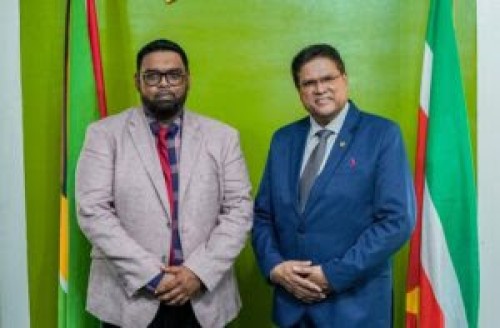Guyana and Suriname Pledge to Protect Vast Swaths of Forests During Speeches at COP28
DUBAI – The Presidents of the neighboring countries of Guyana and Suriname have stated that their vast forests must be protected at all costs.
 Preisdent Dr. Irfaan Ali and President Chandrikapersad SantokhiAs world leaders meet here to decide how the climate crisis can be solved, Suriname’s President Chandrikapersad Santokhi during his three-minute speech at the high-level summit United Nations (UN) climate talks, COP28, said conservation of standing forests and biodiversity should be higher valued than reforestation.”
Preisdent Dr. Irfaan Ali and President Chandrikapersad SantokhiAs world leaders meet here to decide how the climate crisis can be solved, Suriname’s President Chandrikapersad Santokhi during his three-minute speech at the high-level summit United Nations (UN) climate talks, COP28, said conservation of standing forests and biodiversity should be higher valued than reforestation.”
On Friday, his Guyanese counterpart Dr. Irfaan Ali also made the same point.
According to Ali, Guyana has been working, largely on its own, to get compensation for its forest protection efforts since 2009. It has been doing so through its Low Carbon Development Strategy (LCDS).
The countries’ forest credentials are intact. Suriname has the world’s highest national forest cover: 93% of its landmass. Guyana has the second highest at 85%.
Both Presidents argued that compensation won’t just help keep those forests standing, it would also help to protect the rich biodiversity (the plants and animals) there and help support the people who depend on the trees like Indigenous communities.
Two years ago, both leaders were in Glasgow for COP26. And there, they both shared the similar message: countries with vast forests must be paid to keep those intact.
Since then both countries have advanced their case. They are both getting into the carbon market. Guyana already has a deal with one of the oil companies in its lucrative Stabroek Block offshore, the Hess Corporation.
The deal is worth at least US$750 million, with leeway for Guyana to earn more if prices in the carbon market go up.
Suriname, on the other hand, is exploring how it can sell carbon credits under the Paris Agreement in keeping with UN guidelines.
A carbon credit is a kind of tradeable permit or certificate that represents the removal of a certain amount of carbon dioxide from the environment. Since carbon dioxide is the principal greenhouse gas that harms the environment, it is tracked and traded like any other commodity, and hence the name carbon market.
Carbon markets have been the subject of much scrutiny recently and as newcomers, Guyana and Suriname have to figure out how they make this work for them.
But the other elephant in the room for both these countries is their burgeoning oil and gas industries.
That sector is a huge emitter of carbon dioxide and talks on reducing the world’s dependance on oil and gas are abundant at COP28.
Guyana and Suriname want countries to understand their plight.
Santokhi said his country is forced to “adapt to extreme dry and wet weather events which cause losses and damages” because of the climate crisis. Without enough compensation, the country is left, largely, to fend for itself.
He explained that Suriname can now, however, leverage its oil resources to fund its developmental needs.
“… we must respond to the legitimate demands of our population for economic development and diversification,” he said, promising that Suriname will continue to offset carbon from around the world with its forests.
For Guyana, the world’s newest oil hotspot, slashing oil and gas use shouldn’t be the sole focus of plans to solve the climate crisis.
For him, those plans should include the phase out of fossil fuels like oil but also efforts to keep forests intact. And he reminded a gathering at a Guyana side event at COP28 that the demand for energy remains huge- there are countries still grappling with energy poverty- and the existing supply of renewable energy just does not fill that gap.
Balancing these resources to meet developmental needs is a huge focus of the LCDS, the President said.
So they both make it clear, as they continue to protect their forests, they will develop their resources. They only hope that they will get adequate support to do so.


